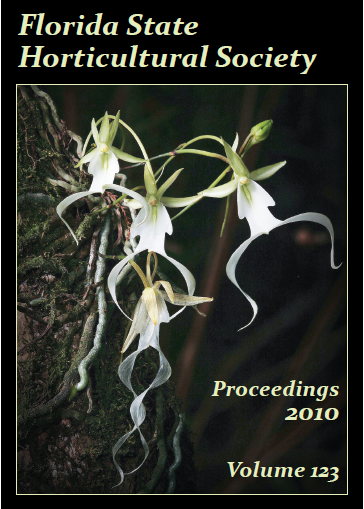Vegetable
Abstract
Phosphorus precipitates out of soil solution and becomes unavailable for plant uptake as soil pH and Ca content increases. The reduced P plant availability in soils with pH >7.0 and Ca concentrations >1000 mg·L–1 renders soil tests using Mehlich 1 extractant ineffective because the acids that make up this extractant can dissolve precipitated P and reflect soil P concentrations not available to plants. The effect of lowering soil pH with S to increase plant availability of fertilizer P is of interest to growers, environmentalists, regulators, and the general public because of improved P availability to crop plants and possible impact of increased S concentrations on the environment. The objective of this field study was to determine the length of time soil pH was reduced by application of S in polyethylene-mulched beds and the subsequent affect on growth and productivity of tomato (Solanum lycopersicum L.). Sulfur was applied to two selected fields at two rates in combination with four P rates. It was determined that the soil pH reduction from the initial S applications rates equivalent to 280 and 560 kg of S per hectare applied only in the planted row lasted less than 60 days and had minimum effect on P availability during the entire crop growing season.References
- Bieleski, R.L. 1973. Phosphate pools, phosphate transport, and phosphate availability. Ann. Rev. Plant Physiol. 24:225–252.
- Cushman, K.E. 2005. Basin vegetable production best management practices. Citrus and Veg. Mag. 69(12):20.
- Gartley, K.L. and J.T. Sims. 1994. Phosphorus soil testing: environmental uses and implications. Commun. Soil Sci. Plant Anal. 25:1565–1582.
- Graetz, D.A. and V.D. Nair. 1995. Fate of phosphorus in Florida Spodosols contaminated with cattle manure. Ecol. Eng. 5:163–181.
- Morgan, K.T., S. Sato, and E. McAvoy. 2009. Preliminary data on phosphorus soil test index validation in Southwest Florida. Proc. Fla. State. Hort. Soc. 122:233–239.
- Nair, V.D. and W.G. Harris. 2004. A capacity factor as an alternative to soil test phosphorus in phosphorus risk assessment. New Zealand J. Agr. Res. 47:491–497.
- Olsen, S.M., and Santos, B. 2010 Vegetable production handbook for Florida. University of Florida, Gainesville.
- Rhue, R.D. and P.H. Everett. 1987. Response of tomatoes to lime and phosphorus on a sandy soil. Agron. J. 79:71–77.
- South Florida Water Management District. 2006. 2007 Draft South Florida environmental report. West Palm Beach, FL.
- South Florida Water Management District. 2009. 2010 Draft South Florida environmental report. West Palm Beach, FL.
- Zhang, M.K., Z.L. He, D.V. Calvert, P.J. Stoffella, Y.C. Li, and E.M. Lamb. 2002. Release potential of phosphorus in Florida sandy soils in relation to phosphorus fractions and adsorption capacity. J. Environ. Sci. Health (Part A) 37:793–809.

